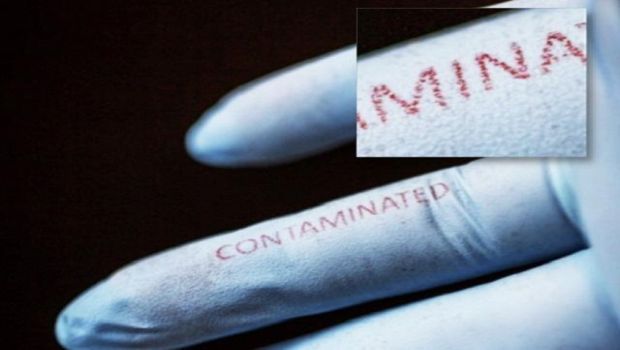Inkjet Inks Made of Silk Could Yield Smart Bandages, Bacteria-Sensing Gloves


Silk inks doped with bacteria-sensing agents were printed on surgical gloves using inkjet technology. The word "contaminated " changed from blue to red after exposure to E. coli. Image courtesy of Omenetto Laboratory/Tufts University
Silk inks containing enzymes, antibiotics, antibodies, nanoparticles and growth factors could turn inkjet printing into a new, more effective tool for therapeutics, regenerative medicine and biosensing, according to new research led by Tufts University biomedical engineers and published June 16 in the journal Advanced Materials online in advance of print.
Inkjet printing is one of the most immediate and accessible forms of printing technology currently available, according to the researchers, and ink-jet printing of biomolecules has been previously proposed by scientists. However, the heat-sensitive nature of these unstable compounds means printed materials rapidly lose functionality, limiting their use.
Enter purified silk protein, or fibroin, which offers intrinsic strength and protective properties that make it well-suited for a range of biomedical and optoelectronic applications. This natural polymer is an ideal "cocoon" that can stabilize compounds such as enzymes, antibodies and growth factors while lending itself to many different mechanically robust formats, says Fiorenzo Omenetto, PhD, senior author on the paper and associate dean for research and Frank C. Doble Professor of Engineering at Tufts School of Engineering.
"We thought that if we were able to develop an inkjet-printable silk solution, we would have a universal building block to generate multiple functional printed formats that could lead to a wide variety of applications in which inks remain active over time," he says.
By using this simple approach and starting with the same base material, the research team created and tested a "custom library" of inkjet-printable, functional silk inks doped with a variety of components:
• Bacterial-sensing polydiacetylenes (PDAs) printed on surgical gloves; the word "contaminated" printed on the glove changed from blue to red after exposure to E. coli
• Proteins that stimulate bone growth (BMP-2) printed on a plastic dish to test topographical control of directed tissue growth
• Sodium ampicillin printed on a bacterial culture to test the effectiveness of a topographical distribution of the antibiotic
• Gold nanoparticles printed on paper, for possible application in photonics and biology (e.g., color engineering, surface plasmon resonance based sensing and bio-imaging)
• Enzymes printed on paper to test the ability of the ink to entrain small functional biomolecules
The researchers, who included collaborators from the University of Illinois at Urbana-Champaign, foresee wide potential for future investigation and application of this technology.
For example, Omenetto envisions more work on the bio-sensing gloves, which he says could selectively react to different pathological agents. The ability to print antibiotics in topographical patterns could address the need for "smart" bandages, where therapeutics are incorporated and delivered to match a complex injury.
The published research was restricted to one ink cartridge, but the scientists believe it could extend to multi-cartridge printing combining complex functions.
In addition to Omenetto, authors on the paper were Hu Tao, former post-doctoral researcher in the Omenetto lab; Benedetto Marelli, Miaomiao Yang and Bo An, of the Department of Biomedical Engineering at Tufts University; Serdar Onses and John Rogers, of the University of Illinois at Urbana-Champaign; and David Kaplan, of the Department of Biomedical Engineering and Department of Chemical and Biological Engineering at Tufts University.
Omenetto and Kaplan are pioneers in the use of silk as an alternative to plastics. Omenetto's 2011 TED Talk called silk a "new old material" that could have a profound impact in many technical fields.
In addition to his engineering appointments, Omenetto is an adjunct professor in the Department of Physics and Astronomy of Tufts' School of Arts and Sciences.
This work was supported by funding from the Office of Naval Research (N14-13-1-0596) and the AFOSR (FA9550-14-1-0015).
Reference: Tao, H., Marelli, B., Yang, M., An, B., Onses, S., Rogers, J. A., Kaplan, D. L. and Omenetto, F. G. (2015), Inkjet Printing of Regenerated Silk Fibroin: From Printable Forms to Printable Functions. Adv. Mater.. doi:10.1002/adma.201501425
Source: Tufts University
Balancing Freedom and Safety: When Public Health Mandates Are Necessary
January 9th 2025Public health mandates, such as lockdowns, masking, and vaccination, balance liberty and safety, ensuring critical protections during pandemics like COVID-19 while fostering long-term survival through science.
Long-Term Chronicles: Infection Surveillance Guidance in Long-Term Care Facilities
January 8th 2025Antibiotic stewardship in long-term care facilities relies on McGeer and Loeb criteria to guide infection surveillance and appropriate prescribing, ensuring better outcomes for residents and reducing resistance.
Considering Avian Flu: World Health Organization Expert Warns Against Raw Milk
January 6th 2025Drinking raw milk poses risks of disease transmission, especially with H5N1 outbreaks. Expert Richard J. Webby, PhD, advises against raw cow or goat milk consumption due to its unpredictable and significant risks.
Avian Flu Risks in Veterinary Practice: Protecting Those on the Frontlines
January 6th 2025Veterinarians, technicians, and veterinarian infection preventionists face risks from H5N1 avian flu when handling farm animals or exposed wildlife. Learn key prevention strategies, PPE recommendations, and emerging challenges.